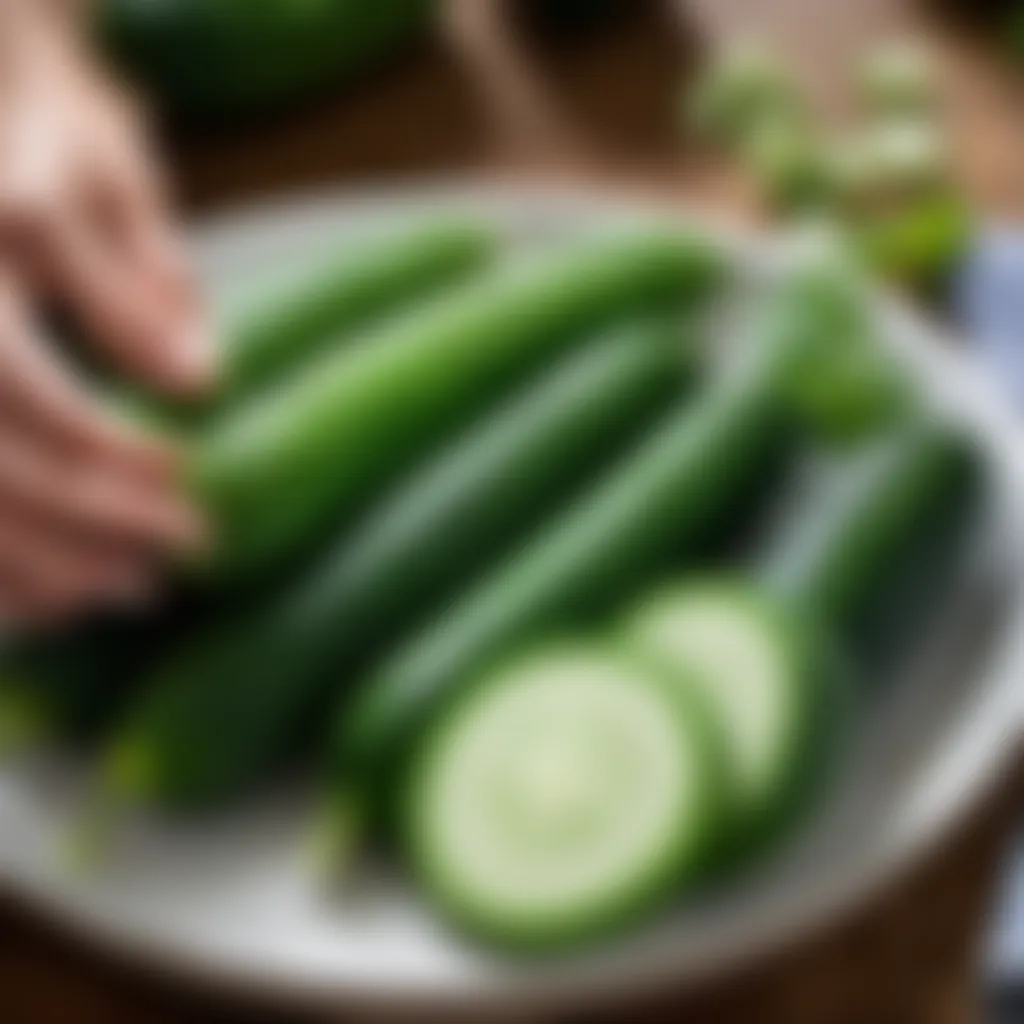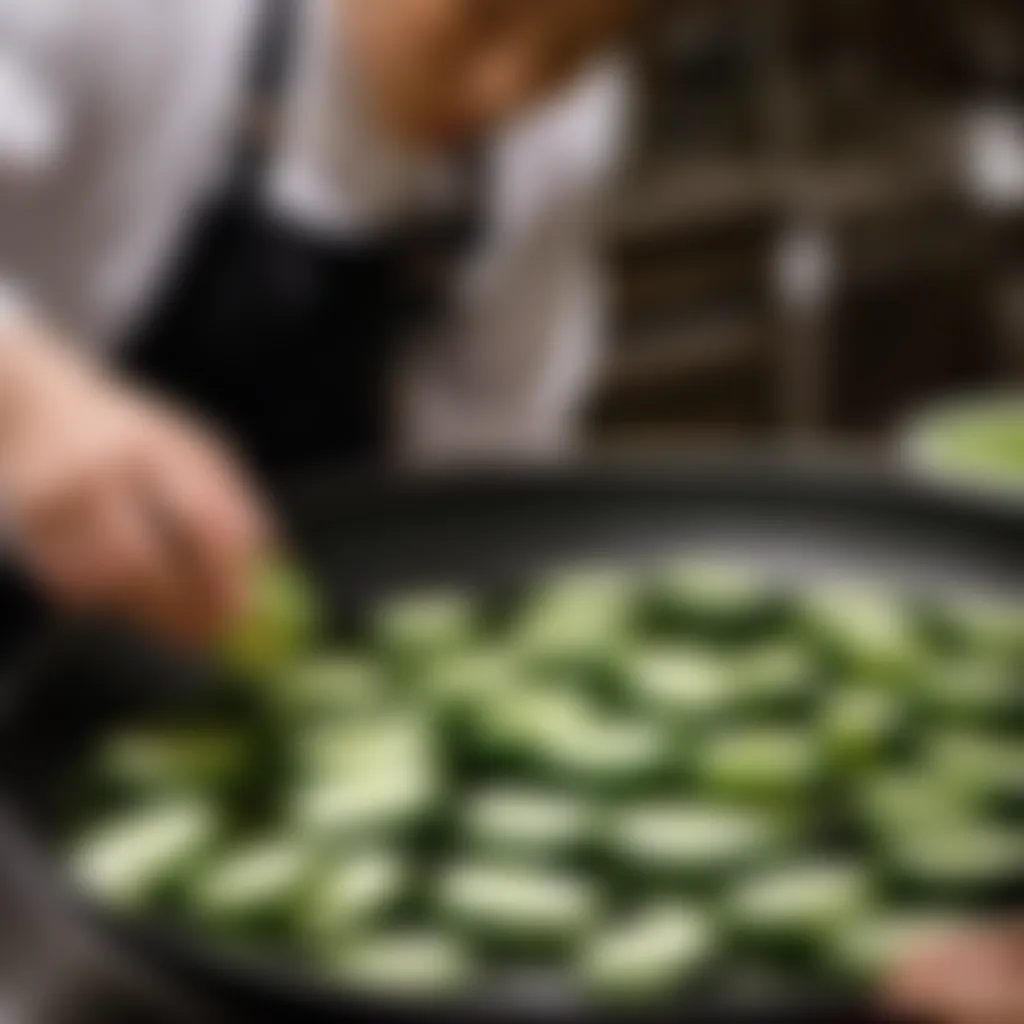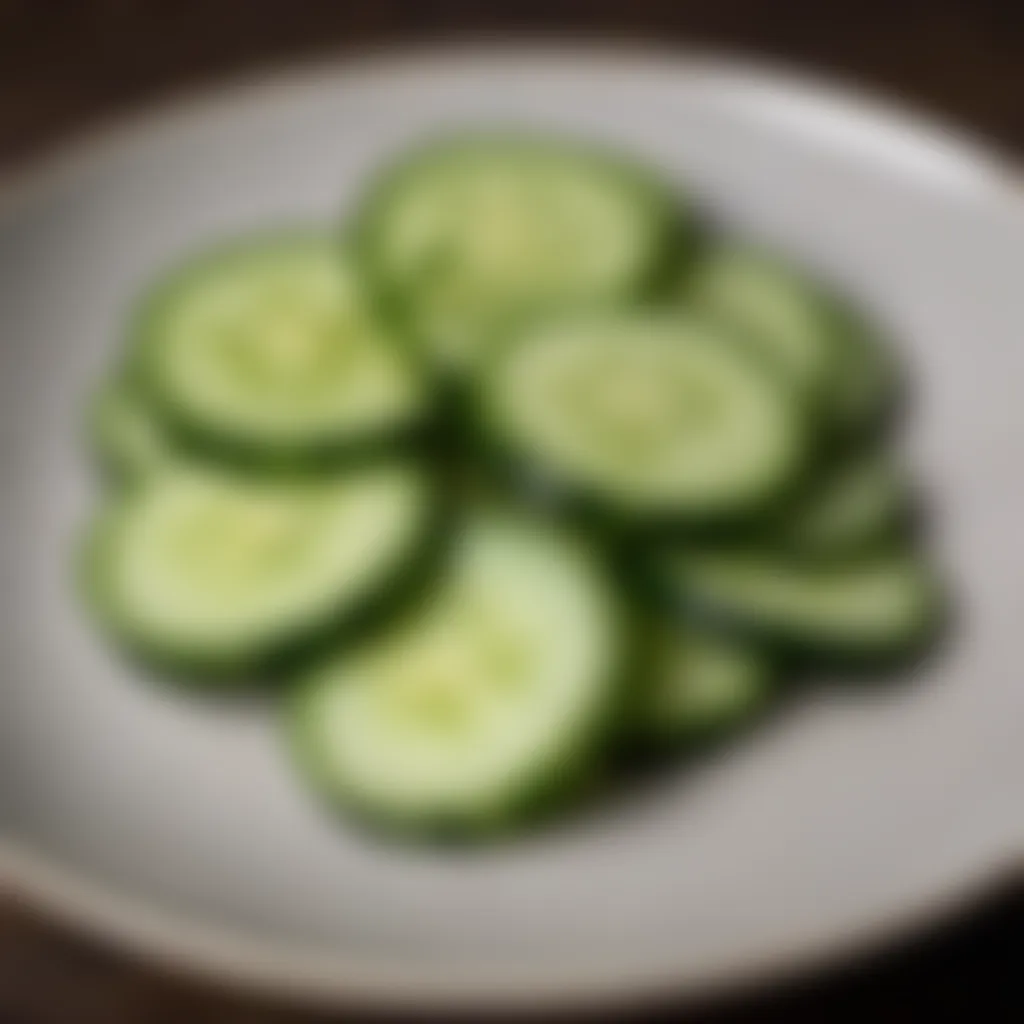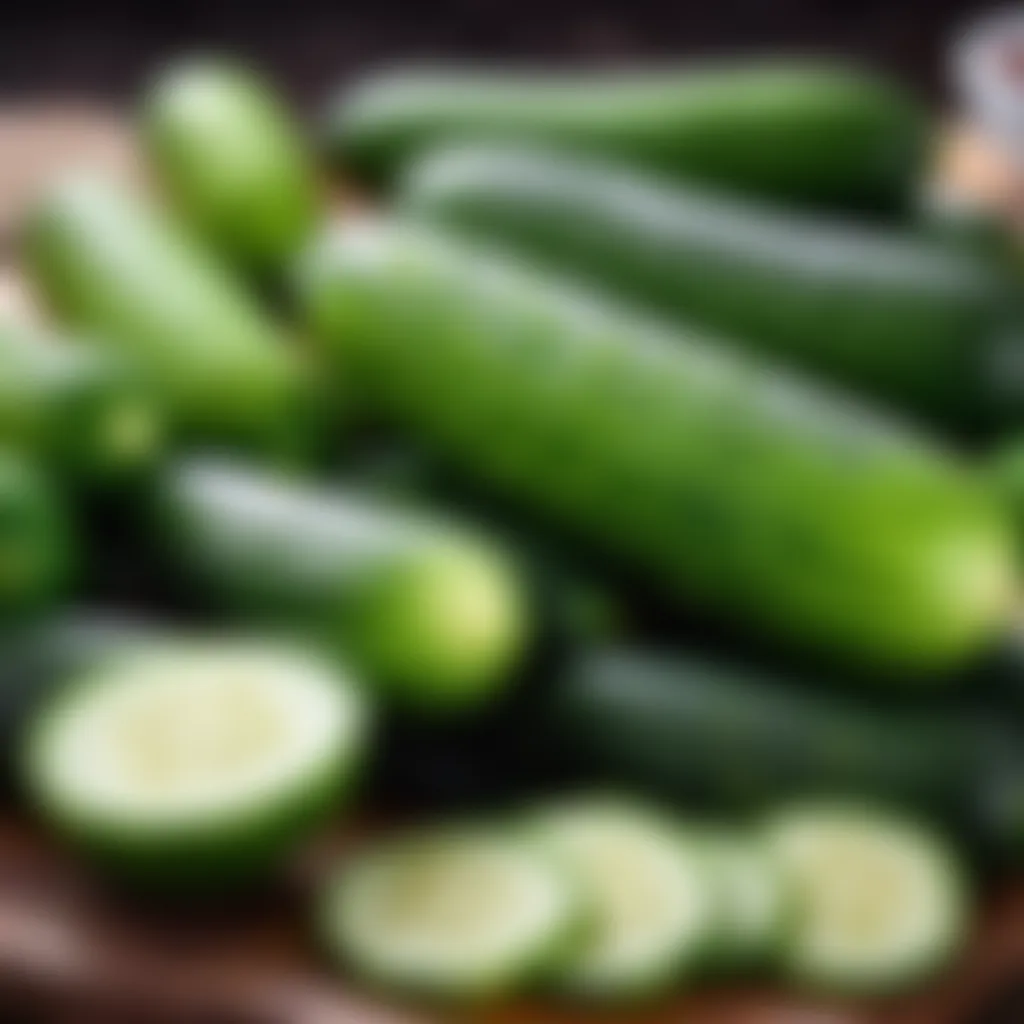Kyurizuke Recipe: Traditional Japanese Pickled Cucumbers


Intro
Kyurizuke, the delightful Japanese pickled cucumber dish, holds a cherished place in the hearts of many. Known for its refreshing taste and vibrant crunch, it’s not just a side dish; it embodies tradition and seasonal flavors. As you embark on this culinary journey, you'll dive into the necessities of crafting kyurizuke at home. Understanding what goes into making this zesty pickle makes the process simpler and much more fulfilling.
The art of making kyurizuke involves using fresh cucumbers, common ingredients like soy sauce and rice vinegar, and a technique that strikes a balance between brininess and sweetness, creating a taste profile that many enjoy. Let’s get down to the nitty-gritty details on how to make this classic dish, starting with the ingredients.
Prologue to Kyurizuke
Kyurizuke, a quintessential component of Japanese cuisine, is more than just a way to preserve cucumbers. It’s a culinary tradition that embodies the essence of the country’s gastronomy, showcasing both the ingredients and the meticulous methods behind its creation. This introduction sets the stage for a deeper exploration into the world of kyurizuke, highlighting its importance within Japanese culture and cuisine.
Definition and Importance
At its core, kyurizuke refers to the pickling of cucumbers utilizing a mix of salt, vinegar, and sometimes a dash of sugar or other flavorings. The resulting dish is a tangy, crunchy delight that serves not only as a side but also as a palate cleanser during meals. Its importance extends beyond mere taste; it represents a time-honored method of food preservation, vital for the colder months when fresh produce can be scarce.
But why should one bother with kyurizuke in today’s fast-paced world? A few reasons come to mind:
- Nutritional Benefits: The probiotics developed during the pickling process contribute to gut health, making kyurizuke not just a tasty choice, but a health-conscious one as well.
- Culinary Versatility: The pickled cucumbers can accompany a variety of dishes, enhancing flavors in rice or noodle preparations, and even invigorating grease-laden meals.
- Cultural Significance: Each jar of kyurizuke is like a capsule of Japanese tradition, connecting generations through shared recipes and techniques.
This careful balance of flavor and health, combined with a nod to the age-old practices of Japanese cooking, makes kyurizuke a significant aspect worth exploring further.
Cultural and Historical Context
Picking up a cucumber and preparing it for kyurizuke can seem simple, yet this practice is rooted deeply in Japan's agricultural and culinary narratives. Cucumber pickling has been a staple in Japanese households for centuries, with records dating back to the Edo period. During this time, people began experimenting with various ingredients and techniques, which laid the groundwork for the variety of pickles enjoyed today.
One interesting note: in Japan, the different regions have their own take on kyurizuke. For instance, Tokyo-style kyurizuke often incorporates a sweeter brine, while Kansai versions might lean more towards sourness. This regional variation reflects not only local taste preferences but also the availability of fresh ingredients.
"Every region has its twist on kyurizuke, showing how adaptable and essential this dish is in celebrating local flavors."
Furthermore, the art of kyurizuke plays a role in seasonal celebrations and family gatherings. It’s not just about food—it’s about creating memories. From family kitchens to restaurant tables, the presence of kyurizuke evokes warmth and a tie to Japanese heritage. With each crunch of a pickle, diners not only savor the flavor but also partake in a tradition that has withstood the test of time.
Ingredients for Kyurizuke
The heart of kyurizuke lies in its ingredients. Each element plays a crucial role in crafting the perfect balance of flavors and textures. Understanding these ingredients not only enriches the experience of making kyurizuke but also enhances appreciation for this traditional dish.
Primary Components
Fresh Cucumbers
Fresh cucumbers are the star of kyurizuke. A key characteristic of cucumbers suitable for pickling is their crispness and freshness. Ideally, you should look for Japanese varieties, known as "kirby," which are shorter and have a delightful crunch. These cucumbers yield a firmer texture upon pickling, making for a satisfying bite. Choosing high-quality cucumbers ensures that the pickled dish retains its fresh flavor, making it a favorable choice for this recipe. Overripe or less firm cucumbers might turn mushy during the pickling process, leading to a less than ideal outcome.
Salt
Salt is not merely a seasoning in kyurizuke; it acts as a vital preservative, drawing out moisture from the cucumbers and enriching their flavor. Korean sea salt or kosher salt is often preferred due to their grain size, which dissolves easily and evenly during the brining process. The unique feature of salt in this recipe lies in its ability to enhance the crispness while permitting the cucumbers to soak in the brine for the right amount of time. However, one must be cautious not to over-salt, as this can overpower the delicate flavor of the cucumbers.
Flavor Enhancers
Rice Vinegar
Rice vinegar is a cornerstone in the flavor profile of kyurizuke. It brings a mild acidity that beautifully complements the natural taste of cucumbers. The key characteristic that sets rice vinegar apart from others is its subtle sweetness, which balances the saltiness and enhances overall palatability. Its delicate flavor is essential for maintaining the authenticity of this dish; however, the wrong choice can lead to an overpoweringly tangy outcome. Therefore, selecting high-quality rice vinegar can elevate your kyurizuke.
Sugar
Sugar adds depth and a hint of sweetness to the pickling brine. It allows for a more rounded flavor, making the dish appealing to those who may not prefer overtly sour notes. The unique feature of sugar in this recipe is its role in counteracting the sharpness of the vinegar. A delicate balance is necessary; too much sugar can lead to an uncharacteristically sweet dish while too little might make the flavors unbalanced. Therefore, thoughtful adjustments can lead to a harmonious flavor profile, striking just the right chord.
Mirin


Mirin, a sweet rice wine essential in Japanese cooking, contributes a unique umami flavor to kyurizuke. This ingredient not only heightens the overall complexity of the taste but also works to tenderize the cucumbers slightly. A key characteristic of mirin is its slight sweetness, aligning well with sugar while providing that extra depth. Many consider it a beneficial addition because it creates a luxurious flavor that elevates the dish. However, if you’re avoiding alcohol or prefer a non-alcoholic option, alternatives like a mix of sugar and rice vinegar can work but may lack the full umami punch.
Optional Additions
Chili Peppers
Chili peppers introduce a delightful heat, making kyurizuke more intriguing. They allow for customization depending on your heat tolerance. The beauty of chili peppers is their versatility; you can include them whole for a mild infusion of heat or chop them for enhanced spiciness. The only downside is that without careful consideration, one might accidentally turn this refreshing dish into an overwhelmingly spicy experience.
Garlic
Adding garlic can give a robust flavor to kyurizuke. When using fresh garlic, it brings a sharpness that enhances the brine. Its unique feature is its potential to add health benefits too, known for its anti-inflammatory properties. However, moderation is key, as too much can overpower the subtleties of the cucumbers and other flavors.
Sesame Seeds
Toasted sesame seeds can be sprinkled onto kyurizuke for an added aromatic touch. They contribute a nutty flavor and pleasant crunch, elevating the textural experience. The appeal of sesame seeds lies in their ability to provide contrast; however, they work best as a garnish post-pickling, since adding them directly into the brine could lead to a soggy texture.
Preparation Steps
Preparation of kyurizuke, or traditional Japanese pickled cucumbers, is crucial for ensuring that each bite reflects the authentic flavors that make this dish unique. Understanding the preparation steps can turn an ordinary cucumber into a delightful complement to many meals. Proper attention at this stage enhances flavors and textures, ultimately optimizing both the eating experience and the longevity of the pickles.
Selecting the Right Cucumbers
Choosing the right cucumbers is the first step toward making kyurizuke, and it can’t be overstated enough. Ideally, you want to go for fresh cucumbers, particularly those labeled as "Japanese" or "Kirby," which are shorter, firmer, and have thinner skin compared to other varieties. These types hold their crunch better during the pickling process and absorb the flavors effectively.
It's also vital to inspect the cucumbers for blemishes or soft spots, which can indicate spoilage. Firm cucumbers not only taste better but also have a longer shelf life post-pickling. For an authentic experience, consider picking them from local farmers' markets, ensuring both freshness and quality for your kyurizuke.
Cucumber Preparation
Washing
The washing step might seem basic, but its importance can't be overlooked. Thoroughly washing your cucumbers helps remove dirt and any pesticides. Rinsing them under cold water while gently scrubbing the skin ensures that not only are they clean but any residual taste from the farm is washed away. This pristine preparation step sets the stage for a cleaner pickle.
Some may choose to soak them in saltwater for a few minutes before rinsing, as this can help open up the tiny pores on the skin, allowing the pickling brine to penetrate better later on.
Slicing Techniques
When it comes to slicing cucumbers for kyurizuke, the method plays a key role in how the flavors meld. While some may prefer thin slices, there’s merit in opting for traditional cuts. Slicing them into wedges or half-moons can provide a satisfying crunch and allow for a beautiful visual presentation.
The unique texture achieved through proper slicing not only improves mouthfeel but also enhances how well each piece absorbs the brine. A thicker slice can yield a more satisfying bite but may take longer to pickle. So, striking a balance is important depending on personal preference.
Making the Pickling Brine
Mixing the Ingredients
The brine serves as the heart of the kyurizuke recipe, blending flavors that allow the cucumbers to shine without overwhelming them. A standard mix comprises salt, rice vinegar, sugar, and mirin, all of which balance sweet and tangy flavors beautifully.
This mixture should ideally be stirred until all ingredients are well combined and the sugar dissolves completely. This step is essential—it ensures uniform flavor distribution among all cucumber pieces, allowing each bite to deliver a hit of umami goodness.
Adjusting Taste
Tinkering with the brine’s flavor is a delightful step. Some might want a sweeter or a more tangy profile depending on their taste buds. Adding more sugar results in a sweeter pickle, while tweaking the vinegar will lean towards a sharper sensation. Remember, maintaining a balance is vital; too much vinegar can overshadow the cucumbers’ delicate taste, while too little sugar might render them bland.
Pickling Process
Layering the Cucumbers
Layering cucumbers in your pickling container is not just a matter of aesthetics; it has practicality. Properly layering pieces helps ensure that the brine fully envelops them, facilitating even pickling. Start by placing a layer of cucumbers, then sprinkle some salt or spice mix, followed by another layer of cucumbers, creating a cycle until the container is full.


This technique also prevents air pockets that could lead to uneven pickling, ensuring that every slice is bathed in the brine.
Resting Time
Once your cucumbers are layered and brined, allowing them a good rest is key to developing flavor. Typically, a minimum resting time of several hours is required, but overnight is often best. This period allows the cucumbers to absorb the brine and flavors fully. The waiting game may be the hardest part, but it’s a crucial step that rewards those who practice patience in the kitchen.
"Good things come to those who wait."
In summary, preparation is vital in crafting kyurizuke. From selecting the right cucumbers to allowing them to pickle appropriately, each step matters. Following the outlined process helps transform simple ingredients into a delicious dish that embodies tradition and flavor.
Fermentation vs. Quick Pickle
When it comes to kyurizuke, the traditional Japanese pickled cucumber dish, understanding the difference between fermentation and quick pickling is pivotal. Each technique offers its own distinct benefits and characteristics that can appeal to different culinary preferences or time constraints.
Understanding Fermentation
Fermentation is a natural process where microorganisms like bacteria and yeast convert sugars into acids, gases, or alcohol. For kyurizuke, this usually results in a tangy flavor that deepens as the cucumbers age. The fermentation process is slower—requiring a specific environment and time, often ranging from several days to weeks.
The cultural significance is profound; fermentation not only preserves food but also enhances its nutritional value, introducing probiotics that promote gut health.
Using kyurizuke as an example, fermented cucumbers develop a distinctive funkiness, bringing a complex taste to dishes like rice bowls or enjoyed simply on their own. Additionally, the flavors improve over time, so patience is essential.
Benefits of Quick Pickling
Now, on the flip side, quick pickling offers a much more immediate reward. In this method, cucumbers are immersed in a brine solution made of vinegar, salt, and sugar, allowing them to absorb flavors in a matter of hours or days, not weeks.
Here are some key benefits of quick pickling:
- Speed: It’s ready in mere hours. Ideal for last-minute meals or spontaneous snacking.
- Simplicity: Requires fewer ingredients and less prep time. You don’t need to fuss about creating a perfect fermentation environment.
- Flavor Control: You can easily tailor the brine to suit your taste—more vinegar for acidity, added sugars for sweetness, and even spices for an extra kick.
- Consistency: Few variables affect quick pickling, making it more reliable, especially for those new to pickling.
"Quick pickles provide instant gratification, perfect for the busy kitchen. They're like a breath of fresh air when you're short on time."
Serving Suggestions
Serving suggestions play a notable role in how Kyurizuke, the delightful pickled cucumber dish, can elevate an ordinary meal into a culinary experience. The way you serve Kyurizuke can enhance its flavor profile and presentation, ensuring it complements the overall dining experience. It’s not just about taste; it’s also about aesthetics and how food is perceived. Choosing the right dishes to accompany Kyurizuke allows home cooks to craft a balanced meal that pays homage to traditional Japanese dining principles. Moreover, understanding the ways to present it can turn a simple homemade dish into a feast for the eyes while reflecting the cultural heritage behind it.
Accompanying Dishes
Rice Dishes
Rice is the backbone of many Japanese meals. When paired with Kyurizuke, rice dishes contribute a textural contrast that brings out the crispness of the pickled cucumbers. White rice, steamed or plain, can serve as a canvas, soaking in the flavors of Kyurizuke without overwhelming its taste. The key characteristic of rice as an accompaniment is its neutral flavor, making it a versatile partner to the brightness of pickles. Serving Kyurizuke alongside a bowl of warm, fluffy rice can create a harmonious balance that satisfies the palate.
A unique feature of rice dishes is their ability to absorb moisture. When topped with Kyurizuke, it enhances the overall flavor profile of the meal — allowing diners to enjoy both the crunch of the cucumber and the soft, warm rice simultaneously. However, one potential drawback is that rice alone can be rather plain. Thus, adding some sesame oil or a sprinkle of furikake can amplify taste considerably and keep things interesting.
Noodle Soups
Noodle soups like miso ramen or soba broth provide a comforting depth that pairs nicely with the crunchy nature of Kyurizuke. The specific aspect of noodle soups is their savory richness; it elevates the fresh, tangy notes of the pickled cucumbers. Whether it’s a clear broth or a creamy miso base, the noodles absorb the various flavors in the soup, allowing the fresh taste of Kyurizuke to shine.
One key benefit of noodle soups is their warmth, offering a soothing experience to diners, especially during cooler months. When served together, the interplay between the hot soup and the zesty cucumbers is delightful. A potential disadvantage, however, is that if not balanced well, the gustatory play could lead to overshadowing the subtleties of Kyurizuke itself. Cooking both dishes with complementary flavors is essential to prevent one from overpowering the other.
Container and Presentation
The choice of container is fundamental to maintaining the integrity of the dish. Traditional Japanese lacquerware or ceramic bowls can accentuate the colors of Kyurizuke and create a sense of authenticity. These materials not only preserve the freshness but also add an artistic touch to the dining experience.
In terms of presentation, consider layering the Kyurizuke on top of the rice or arranging it elegantly beside noodle soup. Plating it this way emphasizes the crunchiness and brightness while also inviting diners to appreciate the visual elements of the meal. Adding garnishes like shiso leaves or toasted sesame seeds can also elevate presentation and flavor. A well-thought-out arrangement transforms a simple, home-cooked meal into a feast, appealing to both the eyes and the palate.
"Food might be a necessity, but presenting it beautifully makes it an experience."


Storage and Shelf Life
Understanding storage and shelf life is crucial when it comes to kyurizuke, the traditional Japanese pickled cucumbers. This step can often be overlooked, but proper storage techniques can directly impact the flavor and texture of your pickles. Not only does it help preserve the freshness, it also enhances your culinary experience. After all, no one wants to savor cucumbers that have gone south!
Optimal Storage Conditions
When it boils down to storage, temperature and containment are your best friends. Ideally, kyurizuke should be kept in the refrigerator to maintain its crunchy texture. A good rule of thumb is to place the pickles in an airtight container. This prevents moisture from seeping in while protecting them from any unwanted odor from other foods, which could alter the taste.
Here are some essential tips:
- Use Glass Containers: Glass does not retain odors and is easy to clean.
- Fill it Up: Try to fill the container as much as possible, minimizing the air space. Less air means less exposure to oxidation.
- Cool Down: Always allow the cucumbers to cool to room temperature before sealing them in containers and storing them in the fridge. This helps avoid condensation inside your container which could lead to spoilage.
Keeping kyurizuke in the fridge can extend its life significantly. You'll be happy to know it can last anywhere from 1 to 3 weeks, provided it’s stored correctly. Remember, the sooner you consume them, the crunchier and tastier they will be!
Signs of Spoilage
Even with the best storage practices, kyurizuke can still spoil. Knowing what to look for is vital to ensure that your pickles remain safe to eat. Here are some telltale signs:
- Texture Changes: If your cucumbers have turned mushy or feel slimy, throw them out. This indicates bacterial growth.
- Unpleasant Odor: A sour smell that deviates from the original tangy scent is a no-go. If you catch a whiff that seems off, it's better to be safe than sorry.
- Discoloration: Small changes in color can be acceptable, but if the color shifts drastically, that’s a warning flag.
- Mold: If you see any visible mold on the surface or the brine, do not attempt to salvage it. Moldy food is not something to take lightly.
Always trust your senses; if it smells funky or looks questionable, it's best to discard it.
Variations of Kyurizuke
Exploring the variations of kyurizuke is like peeling back layers of a delicious onion; while the base remains the same, the flavor and experience can vary greatly based on regional traditions and personal preferences. This diversity in preparation not only adds newfound flavors to the dish but also showcases the cultural richness embedded in Japanese cuisine. Understanding these variations can empower home cooks to adapt the classic recipe, ensuring they find the perfect balance for their palates.
Regional Differences
Within Japan, kyurizuke is known to adopt distinctive identities depending on where it is served. For instance, in the Kanagawa region, people might prefer using a simpler brine with just salt and vinegar, which enhances the cucumber’s natural crunch. In contrast, Kyoto's take may incorporate a touch of umami with the inclusion of kombu, a type of seaweed, bringing out deeper flavors in the pickles.
Some regions also infuse their recipes with local spices or pair them with unique pickling agents. This can turn plain cucumbers into a culinary delight that reflects the area’s agricultural offerings. Plus, these regional adaptations often get passed down through generations, each adding a personal secret or twist. Thus, making kyurizuke can be a delightful journey through Japan's various cultural landscapes.
Here are a few notable regional takes on kyurizuke:
- Hokkaido Style: Utilizes the crispness of young cucumbers combined with a heavier brine seasoned with additional spices like ginger.
- Osaka Style: Known for its sweeter taste due to the use of mirin and larger cuts of cucumbers that marinate well with the generous sugar used.
- Okinawa Style: Incorporates tropical flavors, sometimes using shoyu instead of salt, which gives the pickles a rich, savory profile.
Ingredient Substitutions
While the traditional method for making kyurizuke can be delightful, flexibility in ingredient choices can adapt the appetizer to fit dietary preferences or what one has available in their kitchen. Knowing how to substitute effectively can transform your pickles while still honoring the heart of the dish.
For example, if rice vinegar isn't on hand, apple cider vinegar can serve as a stand-in, imparting a unique tang without straying too far from the original spirit of kyurizuke. If you’re looking to lessen the sweetness, consider using erythritol or another sugar alternative to maintain that essential balance while accommodating various dietary concerns.
Common substitutions include:
- Rice Vinegar: Try apple cider vinegar or white wine vinegar if you’re out.
- Sugar: You may opt for honey or agave syrup for a different sweetness level that still balances flavor.
- Salt: For lower sodium options, kosher salt or sea salt could work, though the texture may slightly change.
These adaptations not only keep the essence of kyurizuke alive but also encourage experimentation, leading to personal discoveries and flavors that elevate an already cherished dish.
The beauty of kyurizuke lies in its versatility, allowing cooks to explore an array of tastes and textures while preserving cultural significance.
Finale
Wrapping up, kyurizuke stands out not just as a dish, but as a cultural hallmark within Japanese cuisine. This traditional pickled cucumber is more than just a side; it reflects the ingenuity and resourcefulness of Japanese culinary practices. Mastering the art of kyurizuke provides a bridge to understanding the significance of preserving food. The pickling process allows the cooling crunch of cucumbers to shine while imparting subtle flavors that can elevate any meal.
Summary of Key Points
To sum it all up:
- Ingredients Matter: Quality cucumbers and the right blend of seasonings are vital for authentic kyurizuke.
- Pickling Techniques: Knowing how to create the brine, layer the cucumbers, and allow adequate resting time is crucial.
- Storage Tips: Proper storage conditions ensure your kyurizuke lasts while preserving its fresh taste.
Encouragement to Try Making Kyurizuke
I encourage all home cooks to dive in and give kyurizuke a try. Not only is it a rewarding experience, but it’s a chance to connect with a centuries-old tradition. By making your own pickled cucumbers, you infuse your meals with a personal touch and flavor that simply cannot be bought. So, gather your ingredients, roll up your sleeves, and embark on this delicious journey. Remember, every batch might be different, and that’s the beauty of it!







